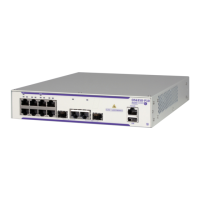VLAN Stacking Commands
OmniSwitch CLI Reference Guide November 2009 page 24-27
ethernet-service uni uni-profile
Associates a VLAN Stacking User Network Interface (UNI) profile with a UNI port.
ethernet-service uni {slot/port1[-port2] | agg_num} uni-profile uni-profile-name
Syntax Definitions
slot/port1 The slot number for the module and the physical port number on that
module (e.g., 3/1 specifies port 1 on slot 3).
-port2 The last port number in a range of ports that you want to configure on
the same slot (e.g, 3/1-4 specifies ports 1, 2, 3, and 4 on slot 3).
agg_num The link aggregate ID number (0–31).
uni-profile-name Alphanumeric string of up to 32 characters. Use quotes around string if
the profile name contains multiple words with spaces between them
(e.g., “Alcatel-Lucent Engineering”).
Defaults
The default profile (default-uni-profile) is used to process control packets ingressing on a UNI port. This
profile is assigned at the time a port is configured as a VLAN Stacking UNI.
Platforms Supported
OmniSwitch 6250-Metro Models
Usage Guidelines
• This UNI specified with this command must already exist in the switch configuration.
• To change the profile associated with a UNI port, use this command and specify a different profile
name than the one currently associated with the port. The last profile associated with the port, is the
profile that is applied to UNI port traffic.
• To change the profile associated with a UNI port back to the default profile, enter “default-uni-profile”
with this command.
Examples
-> ethernet-service uni 1/3 uni-profile uni_1
-> ethernet-service uni 2/10-15 uni-profile default-uni-profile
-> no ethernet-service uni 1/3 uni-profile uni_1
Release History
Release 6.6.1; command was introduced.

